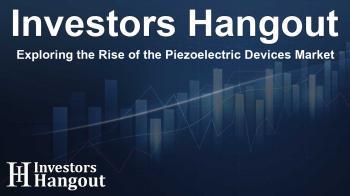Exploring the Rise of the Piezoelectric Devices Market

Growth Projections for the Piezoelectric Devices Market
The international piezoelectric devices market is witnessing a significant upward trajectory, with expectations to soar from USD 35.59 billion in the upcoming years to an impressive USD 55.49 billion by the end of the decade, representing a compound annual growth rate (CAGR) of 7.7%. A driving force behind this growth is the increasing use of piezoelectric materials in the aerospace sector, which seeks innovative solutions to improve the functionality and efficiency of aircraft structures. As major aerospace manufacturers strive to enhance the performance, durability, and efficiency of their products, piezoelectric devices have become essential.
The Role of Piezoelectric Technology in Aviation
In modern aircraft, piezoelectric actuators are critical components employed in active vibration-damping systems. These devices monitor and mitigate unwanted vibrations, reducing noise and energy consumption, which is vital in maintaining optimal performance. Beyond aviation, the adaptability of piezoelectric technology extends to multiple applications including wind turbines, motors, machine tools, and advanced testing setups. This versatility positions piezoelectric materials and devices as vital to resolving prevalent aviation challenges, such as vibrations from engines and efficiency of control surfaces.
Market Segmentation and Material Trends
Among the various product segments, piezoelectric actuators are anticipated to dominate the market, driven by their broad applications across diverse fields such as automotive, aerospace, electronics, and biomedical technologies. Their use spans from gene manipulation to high-precision tasks, reflecting their versatility and necessity in modern engineering solutions. Furthermore, the piezoelectric polymers segment is expected to show exceptional growth, fueled by the rise of wearable technology and advanced medical devices. Materials like PVDF (Polyvinylidene fluoride) exemplify the shift towards lighter and more flexible design requirements, making them suitable for numerous applications.
Regional Insights and Market Drivers
Predictions suggest that the Asia-Pacific region will lead the market in terms of size, largely due to its burgeoning electronics and automotive industries. Countries in this region, particularly China, Japan, and South Korea, are not only advancing their manufacturing capabilities but are also rapidly adopting piezoelectric technologies in various applications such as electric vehicles and advanced driver-assistance systems. As the region continues to invest in renewable energy and healthcare, the demand for innovative piezoelectric solutions is anticipated to surge.
Challenges and Opportunities Ahead
While the market shows promise, there are key hurdles such as high manufacturing costs that companies need to navigate. However, the growing interest in 3D printing technologies presents new opportunities for the industry to innovate further and reduce costs. As industries progress towards automation and sustainability, piezoelectric devices could play a pivotal role in enhancing efficiency and performance in various applications.
Key Industry Players Transforming the Market
Prominent manufacturers like CeramTec GmbH, Kistler Group, and CTS Corporation are at the forefront, continuously developing innovative solutions to meet the rising demand. Their strategic investments in research and development are crucial in maintaining competitive advantage and exploring new market opportunities.
Conclusion: Embracing Future Innovations
As we look ahead, the piezoelectric devices market stands on the brink of a transformative phase, characterized by technological advancements and increasing adoption across multiple sectors. The anticipation of the market's growth towards USD 55.49 billion by the decade's end outlines a vibrant future for piezoelectric innovations. Embracing these technologies will not only support the advancement of existing applications but also foster new ones as industries prioritize efficiency and sustainability.
Frequently Asked Questions
What is the expected market size of the piezoelectric devices market by 2030?
The market is projected to grow to USD 55.49 billion by 2030.
What are the primary drivers of growth for this market?
Rising demand from the aerospace sector and advancements in automotive technologies are key growth drivers.
Which sectors are expected to see the highest usage of piezoelectric devices?
Key sectors include aerospace, automotive, electronics, and biomedical technologies.
What challenges does the piezoelectric devices market face?
High manufacturing costs are a significant challenge for the industry.
Which regions are leading the piezoelectric devices market?
The Asia-Pacific region is expected to account for the largest market share.
About Investors Hangout
Investors Hangout is a leading online stock forum for financial discussion and learning, offering a wide range of free tools and resources. It draws in traders of all levels, who exchange market knowledge, investigate trading tactics, and keep an eye on industry developments in real time. Featuring financial articles, stock message boards, quotes, charts, company profiles, and live news updates. Through cooperative learning and a wealth of informational resources, it helps users from novices creating their first portfolios to experts honing their techniques. Join Investors Hangout today: https://investorshangout.com/
Disclaimer: The content of this article is solely for general informational purposes only; it does not represent legal, financial, or investment advice. Investors Hangout does not offer financial advice; the author is not a licensed financial advisor. Consult a qualified advisor before making any financial or investment decisions based on this article. The author's interpretation of publicly available data shapes the opinions presented here; as a result, they should not be taken as advice to purchase, sell, or hold any securities mentioned or any other investments. The author does not guarantee the accuracy, completeness, or timeliness of any material, providing it "as is." Information and market conditions may change; past performance is not indicative of future outcomes. If any of the material offered here is inaccurate, please contact us for corrections.
